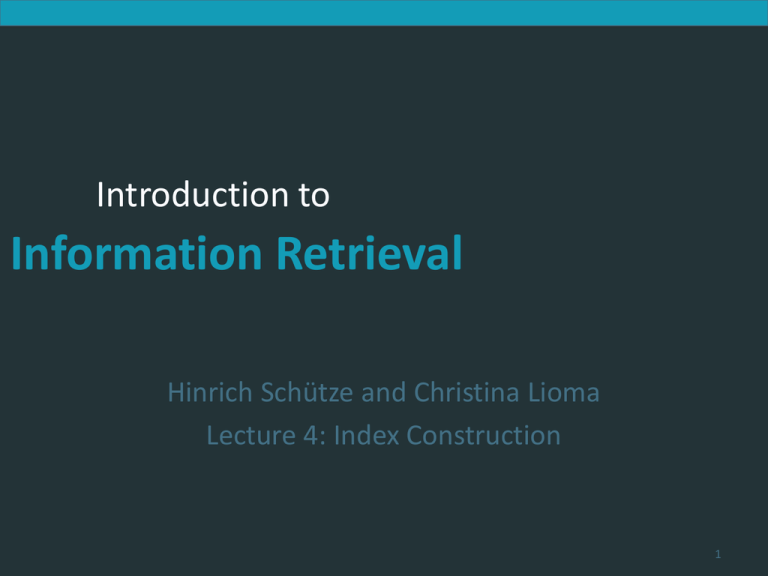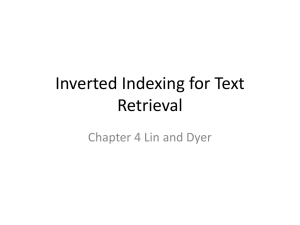Introduction to Information Retrieval
advertisement

Introduction to Information Retrieval Introduction to Information Retrieval Hinrich Schütze and Christina Lioma Lecture 4: Index Construction 1 Introduction to Information Retrieval Outline ❶ Introduction ❷ BSBI algorithm ❸ SPIMI algorithm ❹ Distributed indexing ❺ Dynamic indexing 2 Introduction to Information Retrieval INTRODUCTION 3 Introduction to Information Retrieval Hardware basics Many design decisions in information retrieval are based on hardware constraints. We begin by reviewing hardware basics that we’ll need in this course. 4 Introduction to Information Retrieval Hardware basics Access to data is much faster in memory than on disk. (roughly a factor of 10) Disk seeks are “idle” time: No data is transferred from disk while the disk head is being positioned. To optimize transfer time from disk to memory: one large chunk is faster than many small chunks. Disk I/O is block-based: Reading and writing of entire blocks. Block sizes: 8KB to 256 KB Servers used in IR systems typically have several GB of main memory, sometimes tens of GB, and TBs or 100s of GB of disk space. 5 Introduction to Information Retrieval Some stats (2008) symbol statistic value s b average seek time transfer time per byte processor’s clock rate lowlevel operation (e.g., compare & swap a word) size of main memory size of disk space 5 ms = 5 × 10−3 s 0.02 μs = 2 × 10−8 s 109 s−1 0.01 μs = 10−8 s P several GB 1 TB or more 6 Introduction to Information Retrieval RCV1 collection Shakespeare’s collected works are not large enough for demonstrating many of the points in this course. As an example for applying scalable index construction algorithms, we will use the Reuters RCV1 collection. English newswire articles sent over the wire in 1995 and 1996 (one year). 7 Introduction to Information Retrieval A Reuters RCV1 document 8 Introduction to Information Retrieval Reuters RCV1 statistics N L M T documents tokens per document terms bytes per token (incl. spaces/punct.) bytes per token (without spaces/punct.) bytes per term non-positional postings 800,000 200 400,000 6 4.5 7.5 100,000,000 9 Introduction to Information Retrieval BSBI ALGORITHM Introduction to Information Retrieval Goal: construct the inverted Index dictionary postings 11 Introduction to Information Retrieval Sort postings in memory 12 Introduction to Information Retrieval Sort-based index construction As we build index, we parse docs one at a time. The final postings for any term are incomplete until the end. Can we keep all postings in memory and then do the sort inmemory at the end? No, not for large collections At 10–12 bytes per postings entry, we need a lot of space for large collections. In-memory index construction does not scale for large collections. Thus: We need to store intermediate results on disk. 13 Introduction to Information Retrieval Same algorithm for disk? Can we use the same index construction algorithm for larger collections, but by using disk instead of memory? No: Sorting T = 100,000,000 records on disk is too slow – too many disk seeks. We need an external sorting algorithm. 14 Introduction to Information Retrieval “External” sorting algorithm (using few disk seeks) We must sort T = 100,000,000 non-positional postings. Each posting has size 12 bytes (4+4+4: termID, docID, document frequency). Define a block to consist of 10,000,000 such postings We can easily fit that many postings into memory. We will have 10 such blocks for RCV1. Basic idea of algorithm: For each block: (i) accumulate postings, (ii) sort in memory, (iii)construct the inverted index (iv) write to disk Then merge the blocks into one long sorted order. 15 Introduction to Information Retrieval Merging two blocks 16 Introduction to Information Retrieval Blocked Sort-Based Indexing 17 Introduction to Information Retrieval SPIMI ALGORITHM Introduction to Information Retrieval Problem with sort-based algorithm Our assumption was: we can keep the dictionary in memory. We need the dictionary (which grows dynamically) in order to implement a term to termID mapping. Actually, we could work with term,docID postings instead of termID,docID postings . . . . . . but then intermediate files become very large. (We would end up with a scalable, but very slow index construction method.) 19 Introduction to Information Retrieval Single-pass in-memory indexing Abbreviation: SPIMI Key idea 1: Generate separate dictionaries for each block – no need to maintain term-termID mapping across blocks. Key idea 2: Don’t sort. Accumulate postings in postings lists as they occur. With these two ideas we can generate a complete inverted index for each block. These separate indexes can then be merged into one big index. 20 Introduction to Information Retrieval SPIMI-Invert 21 Introduction to Information Retrieval SPIMI: Compression Compression makes SPIMI even more efficient. Compression of terms Compression of postings See next lecture 22 Introduction to Information Retrieval DISTRIBUTED INDEXING Introduction to Information Retrieval Distributed indexing For web-scale indexing: must use a distributed computer cluster Individual machines are fault-prone. Can unpredictably slow down or fail. How do we exploit such a pool of machines? 24 Introduction to Information Retrieval Distributed indexing Maintain a master machine directing the indexing job – considered “safe” Break up indexing into sets of parallel tasks Master machine assigns each task to an idle machine from a pool. 25 Introduction to Information Retrieval Parallel tasks We will define two sets of parallel tasks and deploy two types of machines to solve them: Parsers Inverters Break the input document collection into splits (corresponding to blocks in BSBI/SPIMI) Each split is a subset of documents. 26 Introduction to Information Retrieval Parsers Master assigns a split to an idle parser machine. Parser reads a document at a time and maps splits to (term,docID)-pairs. Parser writes pairs into j term-partitions. Each for a range of terms’ first letters E.g., a-f, g-p, q-z (here: j = 3) 27 Introduction to Information Retrieval Inverters An inverter collects all (term,docID) pairs (= postings) for one term-partition (e.g., for a-f). Sorts and writes to postings lists 28 Introduction to Information Retrieval Data flow 29 Introduction to Information Retrieval MapReduce The index construction algorithm we just described is an instance of MapReduce. MapReduce is a robust and conceptually simple framework for distributed computing . . . . . .without having to write code for the distribution part. The Google indexing system consisted of a number of phases, each implemented in MapReduce. Index construction was just one phase. 30 Introduction to Information Retrieval Index construction in MapReduce 31 Introduction to Information Retrieval DYNAMIC INDEXING Introduction to Information Retrieval Dynamic indexing Up to now, we have assumed that collections are static. They rarely are: Documents are inserted, deleted and modified. This means that the dictionary and postings lists have to be dynamically modified. 33 Introduction to Information Retrieval Dynamic indexing: Simplest approach Maintain big main index on disk New docs go into small auxiliary index in memory. Search across both, merge results Periodically, merge auxiliary index into big index Deletions: Invalidation bit-vector for deleted docs Filter docs returned by index using this bit-vector 34 Introduction to Information Retrieval Issue with auxiliary and main index Poor search performance during index merge Actually: Merging of the auxiliary index into the main index is not that costly if we keep a separate file for each postings list. Merge is the same as a simple append. But then we would need a lot of files – inefficient. Assumption for the rest of the lecture: The index is one big file. In reality: Use a scheme somewhere in between (e.g., split very large postings lists into several files, collect small postings lists in one file etc.) 35 Introduction to Information Retrieval Logarithmic merge Logarithmic merging amortizes the cost of merging indexes over time. Maintain a series of indexes, each twice as large as the previous one. Keep smallest (Z0) in memory Larger ones (I0, I1, . . . ) on disk If Z0 gets too big (> n), write to disk as I0 . . . or merge with I0 (if I0 already exists) and write merger to I1 etc. 36 Introduction to Information Retrieval Binary numbers: I3I2I1I0 = 23222120 0001 0010 0011 0100 0101 0110 0111 1000 1001 1010 1011 1100 37 Introduction to Information Retrieval 38






